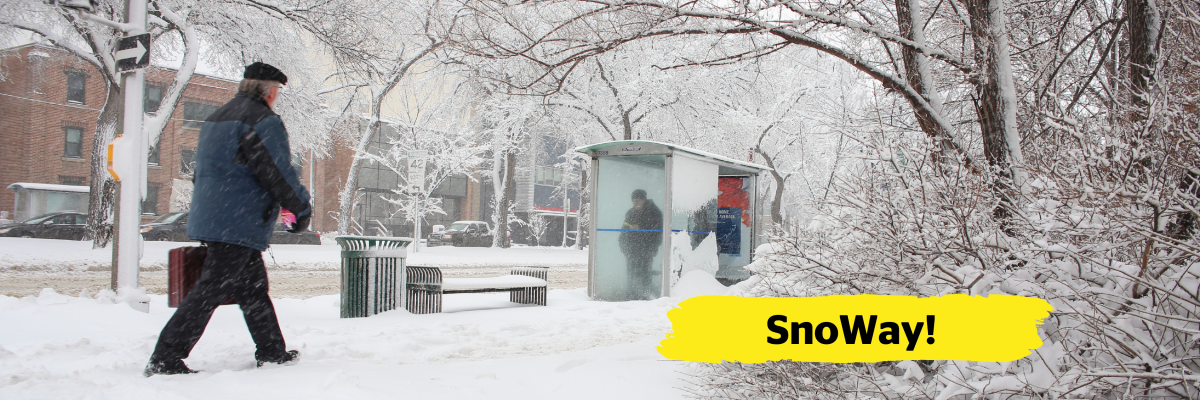Winter weather can mean treacherous travel conditions for millions of pedestrians across Canada, especially for children, seniors, people with strollers and persons with disabilities. Snow and ice-covered sidewalks, crossings and transit routes increase the risk of slip-and-fall accidents for pedestrians and pose serious safety and mobility risks for people who are blind, Deafblind, or have low vision.
Snow removal is an accessibility issue, a mobility issue, and a human rights issue. When municipalities, businesses, snow removal contractors, and homeowners fail to clear snow and ice effectively, people with sight loss cannot safely navigate the built environment in their communities and access public transit, undermining their independence and ability to carry out their daily activities.
Navigating your community after it snows shouldn’t be an obstacle course.
 Sidewalks, crossings, and transit stops are critical and necessary infrastructure for pedestrians and must be safe, accessible, and usable to all – regardless of the season.
Sidewalks, crossings, and transit stops are critical and necessary infrastructure for pedestrians and must be safe, accessible, and usable to all – regardless of the season.
Municipalities, businesses, snow removal contractors, and homeowners have a duty to clear pedestrian pathways of snow and ice within 48 hours following significant snowfall (or sooner if mandated by your municipality) and refrain from depositing snow pile obstructions back onto sidewalks or walkways. This includes residential and public sidewalks in front of homes, private properties, and businesses.
Moreover, municipalities should prioritize pedestrian areas for clearance, especially along public transit routes. Transit stops and shelters must be fully cleared so they are easily identifiable and accessible. At intersections with pedestrian push-buttons like Accessible Pedestrian Signals (APS), sidewalks surrounding the area must be fully cleared of snow and ice so pedestrians can access and activate push-buttons.
Join CNIB in advocating for better snow removal in your region.
Canadians who are blind, Deafblind, or have low vision need to be able to leave their homes confidently, safely, and spontaneously, knowing they can get where they need to go and will be able to find assistance if they encounter an issue. That’s why CNIB has made a commitment to Safe and Accessible Journeys under our 2023-2028 strategic plan, “The Way Forward."
While CNIB continues to advocate for municipalities to review their snow clearing policies and practices, including budgetary decisions, you can take action by participating in our SnoWay campaign.
SnoWay snow removal campaign
 In 2024, CNIB first introduced the SnoWay advocacy campaign to raise awareness among municipalities and the public about the environmental barriers snow and ice-covered sidewalks create and remind them of their responsibility to clear snow and ice from paths of travel.
In 2024, CNIB first introduced the SnoWay advocacy campaign to raise awareness among municipalities and the public about the environmental barriers snow and ice-covered sidewalks create and remind them of their responsibility to clear snow and ice from paths of travel.
This winter, the SnoWay snow removal campaign is back! From November 2025 through March 31, 2026, join us in advocating for safe and accessible journeys for everyone.
Here’s how you can say “SnoWay!” and get involved:
- Shovel your snow! If it's your responsibility, clear snow and ice from your property or arrange for assistance if you’re unable to.
- Talk to your friends, family, neighbours, and local businesses about their snow removal practices – remind them of their responsibility to clear snow and ice from public paths of travel.
- Speak out and file a complaint with your municipality. If you encounter a sidewalk, pathway or transit stop that hasn’t been properly cleared of snow 48 hours after a significant snowfall (or sooner if mandated by your municipality), report it by submitting a complaint (online or by phone). Many municipalities have a centralized 311 number or equivalent service, allowing residents to easily report issues and submit a service request.
- Share a photo on social media that highlights a sidewalk, crosswalk, or transit stop that hasn't been properly cleared of snow/ice. Tag CNIB and your municipality, use the hashtag #SnoWay, and include an image description that details the snow barrier and its location (e.g., the bus stop at the intersection of Bank Street and Queen Street).
Your participation in the SnoWay campaign will contribute to important ongoing discussions about the impacts of improper snow removal practices for people who are blind, Deafblind, or have low vision. We hope you’ll get involved and share your experiences – because everyone should be able to travel safely and independently, regardless of the season.
